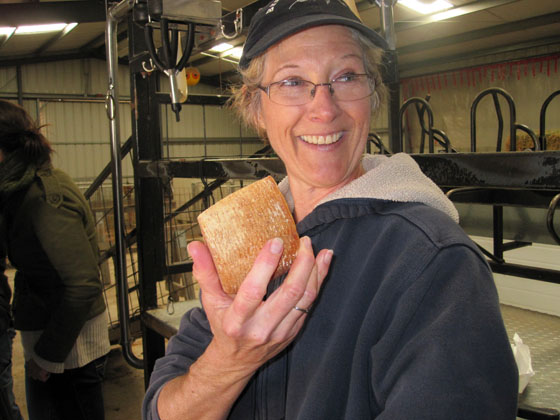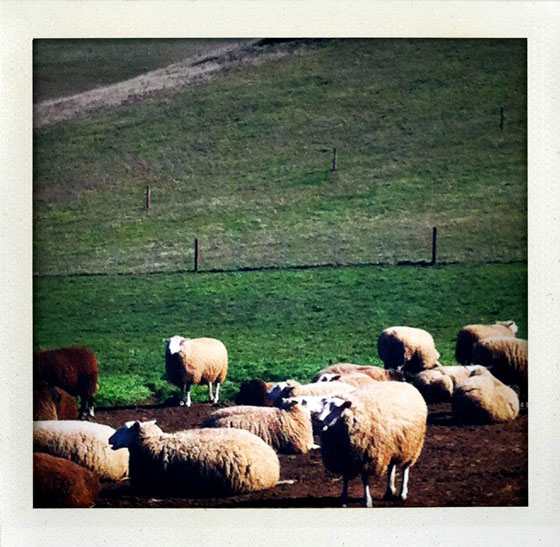She laughed and responded, "Big blocks of orange American cheese. They never thought to make cheese with their sheep's milk!”
Barinaga’s grandparents arrived from Markina and Angoziar in the Basque country to Mountain Home, Idaho in the early 1900s. Her father grew up on a ranch with 5,000 sheep where the main products were lamb and wool. At that time cheesemaking from a herd of ranch sheep was unheard of in Idaho though it was a common practice in the Basque country.
Barinaga’s father eventually left the ranch to become a mechanical engineer in upstate New York where Marcia was raised. “He was unique because he worked for General Electric and he spoke fluent Basque,” she explained. “My father traveled on business to Bilbao for his entire working life, and business trips to Europe in the 1960s lasted at least a month. He got to know all of his Basque family,” unlike his siblings that still worked on the Idaho ranch and were only able to travel to the Basque country once in their lifetime.
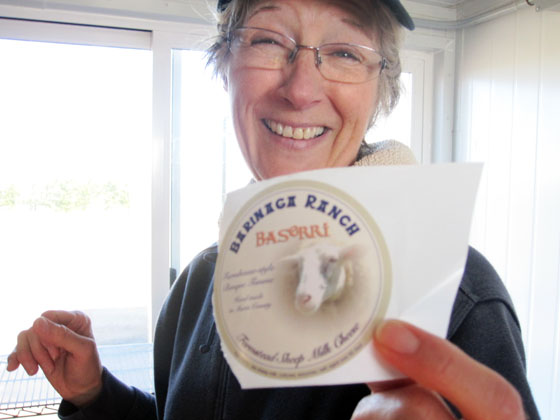
Barinaga shows the label for her Baserri cheese.
Barinaga herself traveled to the Basque country for the first time at age 12, and has since returned five times. “My family there doesn’t speak English, and I don't speak Basque, so we communicate in Spanish--which they speak well, and I speak poorly," she says. "There's a limit to the degree we know each other, but there's love and a great affection.”
And so it was these shepherding cousins that Barinaga turned to when she decided to try her hand at cheesemaking. Shepherding is synonymous with cheesemaking in the Basque country--it would be unheard of to have sheep there and not make cheese from their milk.
When she contacted a cousin to ask for advice on how to begin her new career path, Barinaga says, “He wrote me this email in Spanish, saying:
‘I am so happy you have chosen the life of the baserri. It is not a wealthy life, but it is a rich life.’"
Baserri, in Basque, means both “farmhouse” and can refer to the 'farming life.' Barinaga named her first cheese, a pressed, raw-milk cheese “Baserri.” It’s made in the same manner that Idiazabal, the traditional Basque cheese that has its own DOC (Denomination de Origen, like a wine appellation) is made on both sides of the Pyrenees. On the French side, it's called Ossau-Iraty. A newer addition to the Barinaga cheese lineup is the “Txiki,” (meaning “small”) a miniature version of the Baserri. Both cheeses have a pleasantly nutty taste, a firm texture, and lend themselves well to being eaten on their own in triangles with an accompaniment of figs or chutney, or to being melted into a decadent sandwich.
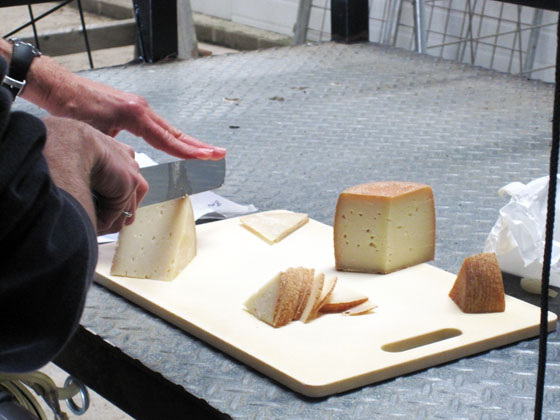
Both of Barinaga's sheep's milk cheeses.
Barinaga also learned aspects of cheesemaking on the French side of the Pyrenees from Luxi and Arno Oxandabarats who taught renowned Vermont cheesemakers Cindy and David Major the tricks to making their acclaimed Vermont Shepherd Cheese. Also in Vermont, Barinaga did an internship of sorts at Hope Farm Sheep Cheese. “I went for a week to learn how to milk sheep,” she explains, “and I learned so much there. So many of my key ideas came from the wonderful generosity and creativity of Harvey and Barb Levin,” she attributes. Among them, a one-of-a-kind cheese press that Harvey Levin designed for her, slanted at a slight angle to provide optimum pressure on the rounds of curds, so that the whey drains evenly from the forms.
“I’m trying to use my PhD in as many ways as I can before I die,” she says of her scientific approach to making cheese.
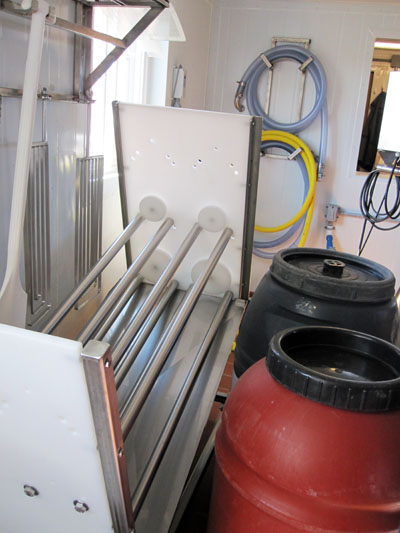
The scientifically-designed cheese press.
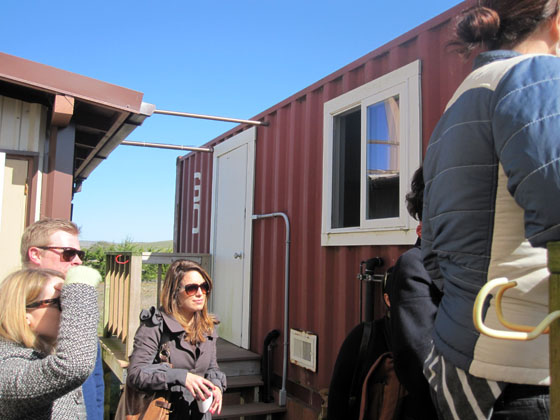
Barinaga Ranch's Creamery
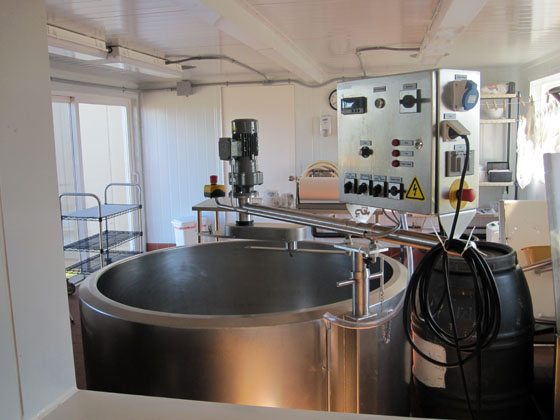
The creamery's interior
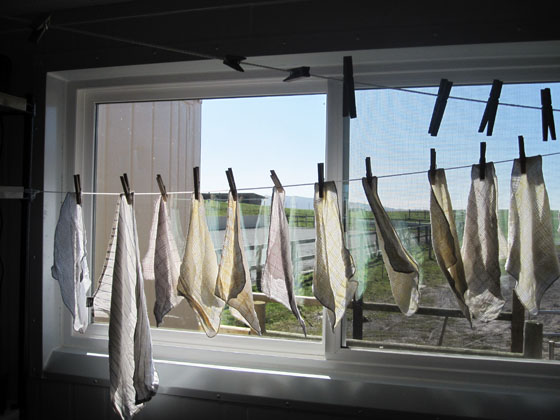
Everything is squeaky clean in the creamery.
Barinaga Ranch’s creamery is made of several shipping containers, a cool modern use of space. It’s clear that Barinaga has great love and respect for her animals. All of the sheep featured on the marketing collateral are actually from her flock. She recognizes and has given many of the 86 ewes names and ensures they are humanely slaughtered once their lambing days are over. Locally made sausage is available for purchase when you tour Barinaga Ranch and you can expect to see Barinaga Ranch charceuterie on a few select San Francisco restaurant menus in the coming year.
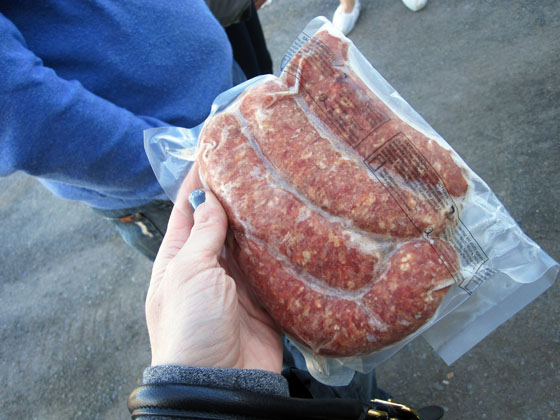
Freshly-made Barinaga Ranch sausage.
“I’ll never send my ewes off to a slaughterhouse to be made into dog food,” she avers. “They have served me faithfully and they deserve better than that.”
Barinaga Ranch cheeses are made from April through early October when the ewes are in their prime milking season, though Saturday tours of the ranch and the creamery are available year-round. On a tour, which can accommodate up to 15 people, visitors can meet the ewes, view a milking session, and perhaps even pet a lamb. Tours are $20 per person, and include a tasting of both Barinaga Ranch cheeses. Should a visitor choose to purchase a wheel of cheese, the price of the tour will be deducted from the price of the cheese. The cheese is available to the consumer once it has aged at least 60 days. From June through December, the 'young' cheese is available, aged 2-3 months. From October through March or April, Barinaga's 'extra-aged' cheese is available, aged 6-9 months.
As for her future plans? Barinaga says, “I would like to rest a little more...but a sheep dairy is certainly not a retirement occupation!”
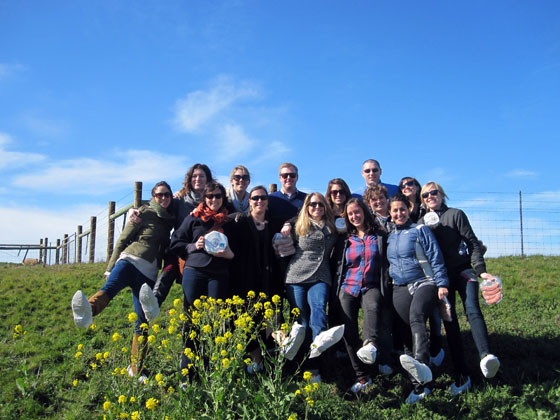
SF chefs, sommeliers, wine importers, and cheesemongers at a tour of Barinaga Ranch.
